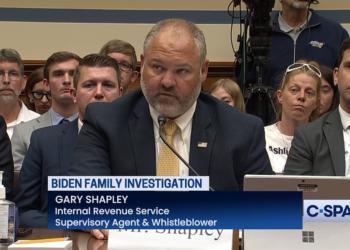President Donald Trump’s tariff agenda has roiled the markets and raised fears of an economic slowdown, raising the stakes for the administration to pass stimulative tax legislation.
Trump on Wednesday announced 10% tariffs on all imports and higher rates on countries that have large trade surpluses with the United States. The Wall Street reaction to “Liberation Day” was swift, with stocks plunging the day after by the most since the pandemic. Some groups are warning economic growth could slow in the coming months as well.
This all puts some increased pressure on Republicans to extend the 2017 Tax Cuts and Jobs Act and further expand those tax cuts, which could please markets and spur economic growth.
Stephen Moore, a Heritage Foundation economist and informal adviser to Trump, acknowledged that the tariffs may have a negative effect on the market, but said that there are other positive economic factors at play, one of which is the tax legislation Republicans are aiming to pass this year.
“Everybody is taking their eye off all the other positive things, the deregulation efforts, the tax reduction, etc.,” Moore told the Washington Examiner. “I would argue those things could have a much more substantially positive impact than Trump’s tariffs would have a negative impact.”
Several major tax provisions in TCJA are set to expire next year and a majority of people would see net tax increases if new legislation isn’t signed into law. Republicans intend to pass this major fiscal overhaul through budget reconciliation, a legislative process that allows for bills to bypass the filibuster and pass with only a simple majority in the Senate.
It is unclear how much further the tax cuts will go beyond extending the 2017 law, but there is the potential for them to be made permanent or for there to other elements that encourage greater business investment.
When asked about the prospect of a big tax cut package helping offset some negative aspects of tariffs, Sen. John Kennedy (R-LA) told the Washington Examiner, “Probably.” Likewise, Sen. Ron Johnson (R-WI) said “it’s a possibility” and that he wanted to see how it all plays out.
The Dow Jones Industrial Average plunged nearly 1,700 points on Thursday in response to the tariffs. The S&P 500 dropped more than 4.8% and the tech-heavy Nasdaq fell more than 1,000 points, shedding nearly 6% of its value in a single day.
While some think that major tax cut legislation, deregulation, and government downsizing can offset the downsides of tariffs, other economists do not.
Ryan Young, a senior economist at the Competitive Enterprise Institute, which generally opposes tariffs, said that an extension of the 2017 tax cuts, which would cost trillions of dollars, isn’t enough to juice economic growth to the level of offsetting the tariffs.
While there will likely be some new tax cuts in the bill, most of the legislation will be about extending existing tax policy. In other words, businesses and individuals aren’t going to experience the shock of suddenly lower taxes as they did back in 2017. Rather, they just won’t see their taxes go up.
“It’s not going to have enough stimulative effect to counteract the tariffs part of its because … they’re extending something that’s already mostly in place,” Young told the Washington Examiner.
Alex Durante, senior economist at the Tax Foundation, said that the tax cuts are already baked into the policy baseline. He said that with a Republican presidency, most businesses and the stock market were likely already pricing in the notion that the Trump tax cuts would be extended.
Still, the White House is projecting strong growth despite the tariffs. The White House Council of Economic Advisers released a report this week that projects that the tax cuts and Trump agenda will significantly accelerate economic growth.
The CEA projects that the extension will boost the level of short-run real gross domestic product by 3.3% to 3.8% and long-run real GDP by 2.6% to 3.2%.
“Going forward, the TCJA’s extension, along with other Administration policies, will continue to produce healthy revenues because of a growing economy,” the report reads. “The 3.0 percent annual real GDP growth forecast under the Administration’s policies is projected to result in $4.1 trillion in additional revenue over the next 10 years relative to the [Congressional Budget Office’s] GDP growth projections that assume the expiration of TCJA.”
The reconciliation bill is likely to be the biggest legislative story of 2025, but the tariffs were as big or bigger in terms of their overall economic significance.
ALLIES SEE SIGNS TRUMP TARIFFS FORCING OTHERS TO LOWER TRADE BARRIERS
Sen. Jim Justice (R-WV) said that he is in wait-and-see mode with the tariffs and used an analogy to illustrate his point.
“Here’s a great example that I would always say, you put your hand in a bucket of water, you jerk your hand out, and just watch the water — I mean for a little while it looks pretty dadgum turbulent, but if you just watch it long enough, it’ll just ease itself out and everything,” he said. “We’ve got to watch this for a little while and see what happens.”














